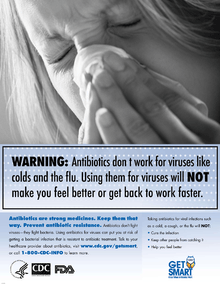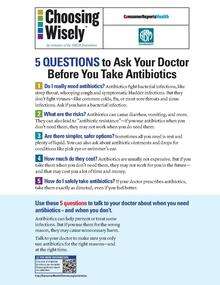Antibiotic misuse

Antibiotic misuse, sometimes called antibiotic abuse or antibiotic overuse, refers to the misuse or overuse of antibiotics, with potentially serious effects on health. It is a contributing factor to the development of antibiotic resistance, including the creation of multidrug-resistant bacteria, informally called "super bugs": relatively harmless bacteria can develop resistance to multiple antibiotics and cause life-threatening infections.[1]
Instances of antibiotic misuse

Common situations in which antibiotics are overused include the following:
- Apparent viral respiratory illness in children should not be treated with antibiotics. If there is a diagnosis of bacterial infection, then antibiotics may be used.[2]
- When children with ear tubes get ear infections, they should have antibiotic eardrops put into their ears to go to the infection rather than having oral antibiotics which are more likely to have unwanted side effects.[3]
- Swimmer's ear should be treated with antibiotic eardrops, not oral antibiotics.[4]
- Sinusitis should not be treated with antibiotics because it is usually caused by a virus, and even when it is caused by a bacteria, antibiotics are not indicated except in atypical circumstances as it usually resolves without treatment.[5]
- Viral conjunctivitis should not be treated with antibiotics. Antibiotics should only be used with confirmation that a patient has bacterial conjunctivitis.[6]
- Older persons often have bacteria in their urine which is detected in routine urine tests, but unless the person has the symptoms of a urinary tract infection, antibiotics should not be used in response.[7]
- Eczema should not be treated with antibiotics. Dry skin can be treated with lotions or other symptom treatments.[8]
- The use of antibiotics to treat surgical wounds does not reduce infection rates in comparison with non-antibiotic ointment or no ointment at all.[8]
Social and economic impact
Antibiotics can cause severe reactions and add significantly to the cost of care.[9] In the United States, antibiotics and anti-infectives are the leading cause of adverse effect from drugs. In a study of 32 States in 2011, antibiotics and anti-infectives accounted for nearly 24 percent of ADEs that were present on admission, and 28 percent of those that occurred during a hospital stay.[10]
Prescribing by an infectious disease specialist compared with prescribing by a non-infectious disease specialist decreases antibiotic consumption and reduces costs.[11]
Antibiotic resistance
Though antibiotics are required to treat severe bacterial infections, misuse has contributed to a rise in bacterial resistance. The overuse of fluoroquinolone and other antibiotics fuels antibiotic resistance in bacteria, which can inhibit the treatment antibiotic-resistant infections.[12][13][14] Their excessive use in children with otitis media has given rise to a breed of bacteria resistant to antibiotics entirely.[15]
Widespread use of fluoroquinolones as a first-line antibiotic has led to decreased antibiotic sensitivity, with negative implications for serious bacterial infections such as those associated with cystic fibrosis, where quinolones are among the few viable antibiotics.[16][17][18]
Inappropriate use

Antibiotics have no effect on viral infections such as the common cold. They are also ineffective against sore throats, which are usually viral and self-resolving.[19] Most cases of bronchitis (90–95%) are viral as well, passing after a few weeks—the use of antibiotics against bronchitis is superfluous and can put the patient at risk of suffering adverse reactions.[20]
Official guidelines by the American Heart Association for dental antibiotic prophylaxis call for the administration of antibiotics to prevent infective endocarditis. Though the current (2007) guidelines dictate more restricted antibiotic use, many dentists[21] and dental patients[22] follow the 1997 guidelines instead, leading to overuse of antibiotics.[23]
Antibiotics in livestock
There has been massive use of antibiotics in animal husbandry. The most abundant use of antimicrobials worldwide are in livestock; they are typically distributed in animal feed or water for purposes such as disease prevention and growth.[24] Debates have arisen surrounding the extent of the impact of these antibiotics, particularly antimicrobial growth promoters, on human antibiotic resistance. Although some sources believe that there remains a lack of knowledge on which antibiotic use generates the most risk to humans,[25] policies and regulations have been placed to limit any harmful effects.
See also
References
- ↑ Harrison JW, Svec TA (April 1998). "The beginning of the end of the antibiotic era? Part II. Proposed solutions to antibiotic abuse". Quintessence International. 29 (4): 223–9. PMID 9643260.
- ↑ American Academy of Pediatrics, "Five Things Physicians and Patients Should Question", Choosing Wisely: an initiative of the ABIM Foundation, American Academy of Pediatrics, retrieved 1 August 2013, which cites
- American Academy of Pediatrics Subcommittee on Diagnosis and Management of Bronchiolitis (2006). "Diagnosis and Management of Bronchiolitis". Pediatrics. 118 (4): 1774–1793. doi:10.1542/peds.2006-2223. PMID 17015575.
- Shulman, S. T.; Bisno, A. L.; Clegg, H. W.; Gerber, M. A.; Kaplan, E. L.; Lee, G.; Martin, J. M.; Van Beneden, C. (2012). "Clinical Practice Guideline for the Diagnosis and Management of Group a Streptococcal Pharyngitis: 2012 Update by the Infectious Diseases Society of America". Clinical Infectious Diseases. 55 (10): e86–102. doi:10.1093/cid/cis629. PMID 22965026.
- ↑ American Academy of Otolaryngology – Head and Neck Surgery, "Five Things Physicians and Patients Should Question", Choosing Wisely: an initiative of the ABIM Foundation, American Academy of Otolaryngology – Head and Neck Surgery, retrieved 1 August 2013, which cites
- Rosenfeld, R. M.; Schwartz, S. R.; Pynnonen, M. A.; Tunkel, D. E.; Hussey, H. M.; Fichera, J. S.; Grimes, A. M.; Hackell, J. M.; Harrison, M. F.; Haskell, H.; Haynes, D. S.; Kim, T. W.; Lafreniere, D. C.; LeBlanc, K.; Mackey, W. L.; Netterville, J. L.; Pipan, M. E.; Raol, N. P.; Schellhase, K. G. (2013). "Clinical Practice Guideline: Tympanostomy Tubes in Children". Otolaryngology -- Head and Neck Surgery. 149 (1 Suppl): S1–S35. doi:10.1177/0194599813487302. ISSN 0194-5998. PMID 23818543.
- ↑ American Academy of Otolaryngology – Head and Neck Surgery (February 2013), "Five Things Physicians and Patients Should Question", Choosing Wisely: an initiative of the ABIM Foundation, American Academy of Otolaryngology – Head and Neck Surgery, retrieved 1 August 2013, which cites
- Rosenfeld, R.; Brown, L.; Cannon, C.; Dolor, R.; Ganiats, T.; Hannley, M.; Kokemueller, P.; Marcy, S.; Roland, P.; Shiffman, R.; Stinnett, S. S.; Witsell, D. L.; American Academy of Otolaryngology--Head Neck Surgery Foundation (2006). "Clinical practice guideline: Acute otitis externa". Otolaryngology - Head and Neck Surgery. 134 (4): S4–23. doi:10.1016/j.otohns.2006.02.014. PMID 16638473.
- ↑ Consumer Reports; American Academy of Allergy, Asthma, and Immunology (July 2012), "Treating sinusitis: Don't rush to antibiotics" (PDF), Choosing Wisely: an initiative of the ABIM Foundation, Consumer Reports, retrieved 14 August 2012
- ↑ American Academy of Ophthalmology (September 2013), "Five Things Physicians and Patients Should Question", Choosing Wisely: an initiative of the ABIM Foundation, American Academy of Ophthalmology, retrieved 6 January 2013, which cites
- Sheikh, Aziz; Hurwitz, Brian; Sheikh, Aziz (2006). "Antibiotics versus placebo for acute bacterial conjunctivitis" (2): CD001211. doi:10.1002/14651858.CD001211.pub2. PMID 16625540.
- ↑ American Geriatrics Society, "Five Things Physicians and Patients Should Question", Choosing Wisely: an initiative of the ABIM Foundation, American Geriatrics Society, retrieved 1 August 2013
- 1 2 American Academy of Dermatology (February 2013), "Five Things Physicians and Patients Should Question", Choosing Wisely: an initiative of the ABIM Foundation, American Academy of Dermatology, retrieved 5 December 2013, which cites
- ↑ Beringer PM, Wong-Beringer A, Rho JP (January 1998). "Economic aspects of antibacterial adverse effects". PharmacoEconomics. 13 (1 Pt 1): 35–49. doi:10.2165/00019053-199813010-00004. PMID 10175984.
- ↑ Weiss AJ, Elixhauser A. Origin of Adverse Drug Events in U.S. Hospitals, 2011. HCUP Statistical Brief #158. Agency for Healthcare Research and Quality, Rockville, MD. July 2013.
- ↑ Beović, B., Kreft., S., Seme, K., Čižman, M. (2009). The Impact of Total Control of Antibiotic Prescribing by Infectious Disease Specialist on Antibiotic Consumption and Cost. Journal of Chemotherapy, 21, 1: 46-51 http://www.tandfonline.com/doi/abs/10.1179/joc.2009.21.1.46
- ↑ Neuhauser MM, Weinstein RA, Rydman R, Danziger LH, Karam G, Quinn JP (February 2003). "Antibiotic resistance among gram-negative bacilli in US intensive care units: implications for fluoroquinolone use". JAMA. 289 (7): 885–8. doi:10.1001/jama.289.7.885. PMID 12588273.
- ↑ "Studies examine prescribing of antibiotics for respiratory infections in hospital emergency departments". USA: U.S. Department of Health and Human Services.
From 1995 to 2002, inappropriate antibiotic prescribing for acute respiratory infections, which are usually caused by viruses and thus are not responsive to antibiotics, declined from 61% to 49%. However, the use of broad-spectrum antibiotics such as the fluoroquinolones, jumped from 41% to 77% from 1995 to 2001. Overuse of these antibiotics will eventually render them useless for treating antibiotic-resistant infections, for which broad-spectrum antibiotics are supposed to be reserved.
- ↑ "Fluoroquinolone Resistance and Tuberculosis Treatment". USA: The New York City Department of Health and Mental Hygiene.
- ↑ Froom J; Culpepper L; Jacobs M; et al. (July 1997). "Antimicrobials for acute otitis media? A review from the International Primary Care Network". BMJ. 315 (7100): 98–102. doi:10.1136/bmj.315.7100.98. PMC 2127061
 . PMID 9240050.
. PMID 9240050. - ↑ "Cipro, Related Antibiotics Over-Prescribed, Fueling Microbe Resistance". USA: University Of California. 1 October 2002. Retrieved 13 August 2009.
- ↑ K. Bassett; B. Mintzes; V. Musini; T.L. Perry Jr; M. Wong; J.M. Wright (November 2002). "Therapeutics Letter" (PDF). Canadian Family Physician. 48.
Gatifloxacin and moxifloxacin have no proven clinical advantages over other fluoroquinolones, macrolides, or amoxicillin. Based on cost, they are not first-choice drugs for their approved indications.
- ↑ Ziganshina LE, Squire SB (2008). Ziganshina LE, ed. "Fluoroquinolones for treating tuberculosis". Cochrane Database of Systematic Reviews (1): CD004795. doi:10.1002/14651858.CD004795.pub3. PMID 18254061.
- ↑ Little P, Gould C, Williamson I, Warner G, Gantley M, Kinmonth AL (August 1997). "Reattendance and complications in a randomised trial of prescribing strategies for sore throat: the medicalising effect of prescribing antibiotics". BMJ. 315 (7104): 350–2. doi:10.1136/bmj.315.7104.350. PMC 2127265
 . PMID 9270458.
. PMID 9270458. - ↑ Hueston WJ (March 1997). "Antibiotics: neither cost effective nor 'cough' effective". The Journal of Family Practice. 44 (3): 261–5. PMID 9071245.
- ↑ Zadik Y; Findler M; Livne S; et al. (December 2008). "Dentists' knowledge and implementation of the 2007 American Heart Association guidelines for the prevention of infective endocarditis". Oral Surg Oral Med Oral Pathol Oral Radiol Endod. 106 (6): e16–9. doi:10.1016/j.tripleo.2008.08.009. PMID 19000604.
- ↑ Elad S, Binenfeld-Alon E, Zadik Y, Aharoni M, Findler M (March 2011). "Survey of acceptance of the 2007 American Heart Association guidelines for the prevention of infective endocarditis: a pilot study". Quintessence Int. 42 (3): 243–51. PMID 21465012.
- ↑ Wilson W; Taubert KA; Gewitz M; et al. (October 2007). "Prevention of infective endocarditis: guidelines from the American Heart Association". Circulation. 116 (15): 1736–54. doi:10.1161/CIRCULATIONAHA.106.183095. PMID 17446442.
- ↑ Silbergeld, E.K.; Graham, J.; Price, L.B. (2008), "Industrial food animal production, antimicrobial resistance, and human health", Annual Review of Public Health, 29: 151–169, doi:10.1146/annurev.publhealth.29.020907.090904, PMID 18348709
- ↑ Landers, T.F.; Cohen, B.; Wittum, T.E.; Larson, E.L. (2012), "A review of antibiotic use in food animals: Perspective, policy, and potential", Public Health Reports, 127 (1): 4–22, PMC 3234384
 , PMID 22298919
, PMID 22298919
Further reading
- Blaser, Martin J. (2014). Missing microbes : how the overuse of antibiotics is fueling our modern plagues. Henry Holt and Company. ISBN 978-0805098105.
External links
- Get Smart: Know When Antibiotics Work, provided by the Centers for Disease Control and Prevention
- Antibiotics: Misuse puts you and others at risk provided by the Mayo Clinic
